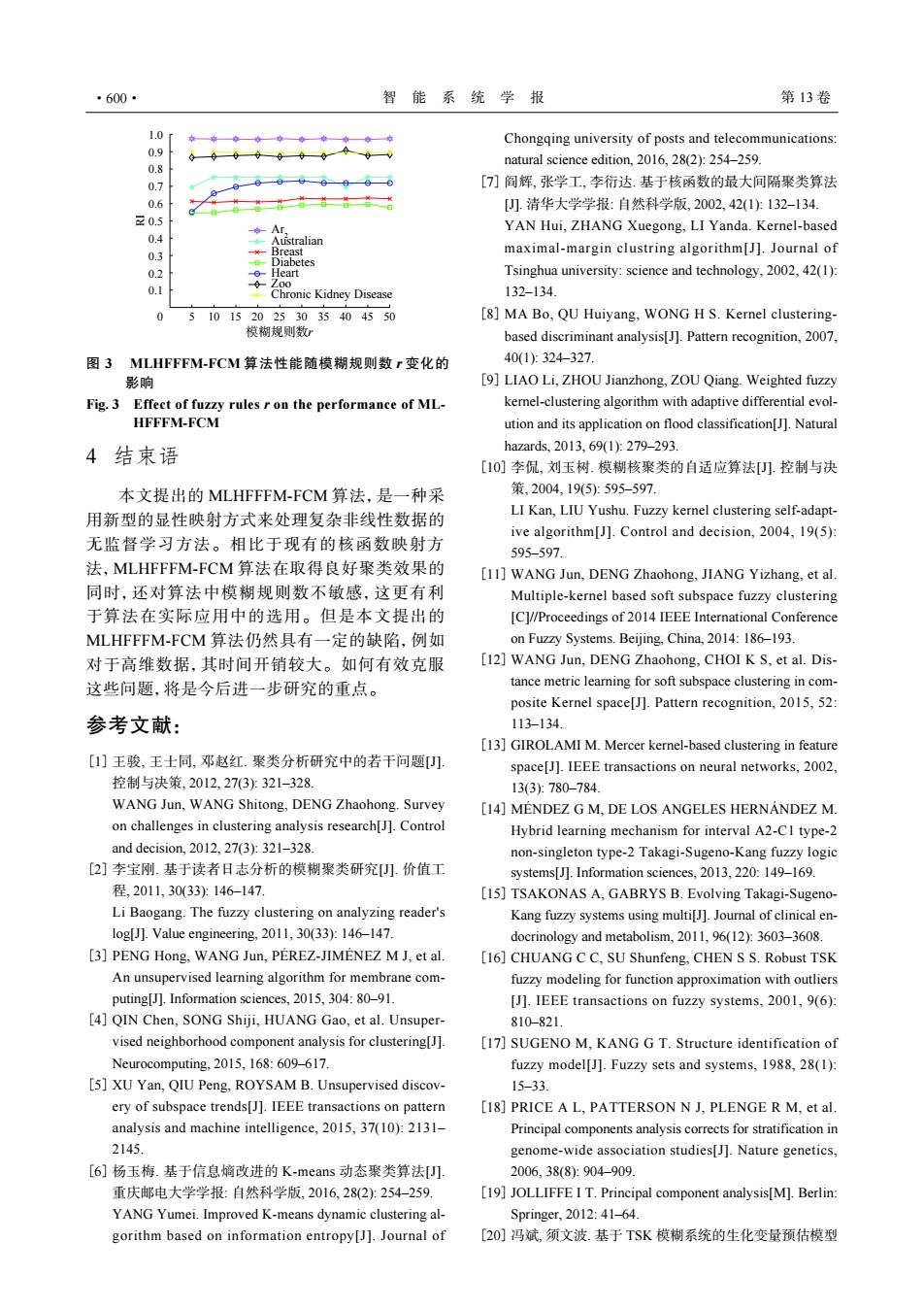正在加载图片...

·600· 智能系统学报 第13卷 1.0r Chongqing university of posts and telecommunications 0.9 natural science edition.2016.28(2):254-259. 0.8 0.7 [7]阎辉,张学工,李衍达.基于核函数的最大间隔聚类算法 0.6 [.清华大学学报:自然科学版,2002,42(1)132-134. ¥0.5 --Ar. YAN Hui,ZHANG Xuegong,LI Yanda.Kernel-based 0.4 Australian 0.3 Breast maximal-margin clustring algorithm[J].Journal of Diabetes 0.2 -e-Heart Tsinghua university:science and technology,2002,42(1): 0.1 0-Z00 Chronic Kidney Disease 132-134 0 5101520253035404550 [8]MA Bo,QU Huiyang,WONG H S.Kernel clustering- 模糊规则数, based discriminant analysis[J].Pattern recognition,2007, 图3 MLHFFFM-FCM算法性能随模糊规则数r变化的 40(1)324327. 影响 [9]LIAO Li,ZHOU Jianzhong,ZOU Qiang.Weighted fuzzy Fig.3 Effect of fuzzy rules r on the performance of ML- kernel-clustering algorithm with adaptive differential evol- HFFFM-FCM ution and its application on flood classification[J].Natural 4结束语 hazards.2013,69(1)279-293. [10]李侃,刘玉树.模糊核聚类的自适应算法[几.控制与决 本文提出的MLHFFFM-FCM算法,是一种采 策,2004,195):595-597 用新型的显性映射方式来处理复杂非线性数据的 LI Kan,LIU Yushu.Fuzzy kernel clustering self-adapt- ive algorithm[J].Control and decision,2004,19(5) 无监督学习方法。相比于现有的核函数映射方 595-597. 法,MLHFFFM-FCM算法在取得良好聚类效果的 [11]WANG Jun,DENG Zhaohong,JIANG Yizhang,et al 同时,还对算法中模糊规则数不敏感,这更有利 Multiple-kernel based soft subspace fuzzy clustering 于算法在实际应用中的选用。但是本文提出的 [C]//Proceedings of 2014 IEEE International Conference MLHFFFM-FCM算法仍然具有一定的缺陷,例如 on Fuzzy Systems.Beijing,China,2014:186-193. 对于高维数据,其时间开销较大。如何有效克服 [12]WANG Jun.DENG Zhaohong,CHOI K S,et al.Dis- 这些问题,将是今后进一步研究的重点。 tance metric learning for soft subspace clustering in com- posite Kernel space[J].Pattern recognition,2015,52: 参考文献: 113-134 [13]GIROLAMI M.Mercer kernel-based clustering in feature [1]王骏,王土同,邓赵红.聚类分析研究中的若干问题[) space[J].IEEE transactions on neural networks,2002, 控制与决策,2012,27(3:321-328. 13(3):780-784. WANG Jun,WANG Shitong,DENG Zhaohong.Survey [14]MENDEZ G M,DE LOS ANGELES HERNANDEZ M. on challenges in clustering analysis research[J].Control Hybrid learning mechanism for interval A2-CI type-2 and decision,2012,27(3):321-328 non-singleton type-2 Takagi-Sugeno-Kang fuzzy logic [2]李宝刚.基于读者日志分析的模糊聚类研究).价值工 systems[J].Information sciences,2013,220:149-169. 程,2011,30(33:146-147. [15]TSAKONAS A.GABRYS B.Evolving Takagi-Sugeno- Li Baogang.The fuzzy clustering on analyzing reader's Kang fuzzy systems using multi[J].Journal of clinical en- log[J].Value engineering,2011,30(33):146-147. docrinology and metabolism,2011,96(12):3603-3608. [3]PENG Hong,WANG Jun,PEREZ-JIMENEZ M J,et al. [16]CHUANG CC,SU Shunfeng,CHEN SS.Robust TSK An unsupervised learning algorithm for membrane com- fuzzy modeling for function approximation with outliers puting[J].Information sciences,2015,304:80-91. [J].IEEE transactions on fuzzy systems,2001,9(6): [4]QIN Chen,SONG Shiji,HUANG Gao,et al.Unsuper- 810-821. vised neighborhood component analysis for clustering[J]. [17]SUGENO M.KANG G T.Structure identification of Neurocomputing,2015,168:609-617. fuzzy model[J].Fuzzy sets and systems,1988,28(1): [5]XU Yan,QIU Peng,ROYSAM B.Unsupervised discov- 15-33. ery of subspace trends[J].IEEE transactions on pattern [18]PRICE A L,PATTERSON N J,PLENGE R M,et al. analysis and machine intelligence,2015,37(10):2131- Principal components analysis corrects for stratification in 2145. genome-wide association studies[J].Nature genetics, [6]杨玉梅.基于信息嫡改进的K-means动态聚类算法[J 2006.38(8):904-909. 重庆邮电大学学报:自然科学版,2016,28(2):254-259, [19]JOLLIFFE I T.Principal component analysis[M].Berlin: YANG Yumei.Improved K-means dynamic clustering al- Springer,2012:41-64. gorithm based on information entropy[J].Journal of [20]冯斌,须文波.基于TSK模糊系统的生化变量预估模型4 结束语 本文提出的 MLHFFFM-FCM 算法,是一种采 用新型的显性映射方式来处理复杂非线性数据的 无监督学习方法。相比于现有的核函数映射方 法,MLHFFFM-FCM 算法在取得良好聚类效果的 同时,还对算法中模糊规则数不敏感,这更有利 于算法在实际应用中的选用。但是本文提出的 MLHFFFM-FCM 算法仍然具有一定的缺陷,例如 对于高维数据,其时间开销较大。如何有效克服 这些问题,将是今后进一步研究的重点。 参考文献: 王骏, 王士同, 邓赵红. 聚类分析研究中的若干问题[J]. 控制与决策, 2012, 27(3): 321–328. WANG Jun, WANG Shitong, DENG Zhaohong. Survey on challenges in clustering analysis research[J]. Control and decision, 2012, 27(3): 321–328. [1] 李宝刚. 基于读者日志分析的模糊聚类研究[J]. 价值工 程, 2011, 30(33): 146–147. Li Baogang. The fuzzy clustering on analyzing reader's log[J]. Value engineering, 2011, 30(33): 146–147. [2] PENG Hong, WANG Jun, PÉREZ-JIMÉNEZ M J, et al. An unsupervised learning algorithm for membrane computing[J]. Information sciences, 2015, 304: 80–91. [3] QIN Chen, SONG Shiji, HUANG Gao, et al. Unsupervised neighborhood component analysis for clustering[J]. Neurocomputing, 2015, 168: 609–617. [4] XU Yan, QIU Peng, ROYSAM B. Unsupervised discovery of subspace trends[J]. IEEE transactions on pattern analysis and machine intelligence, 2015, 37(10): 2131– 2145. [5] 杨玉梅. 基于信息熵改进的 K-means 动态聚类算法[J]. 重庆邮电大学学报: 自然科学版, 2016, 28(2): 254–259. YANG Yumei. Improved K-means dynamic clustering algorithm based on information entropy[J]. Journal of [6] Chongqing university of posts and telecommunications: natural science edition, 2016, 28(2): 254–259. 阎辉, 张学工, 李衍达. 基于核函数的最大间隔聚类算法 [J]. 清华大学学报: 自然科学版, 2002, 42(1): 132–134. YAN Hui, ZHANG Xuegong, LI Yanda. Kernel-based maximal-margin clustring algorithm[J]. Journal of Tsinghua university: science and technology, 2002, 42(1): 132–134. [7] MA Bo, QU Huiyang, WONG H S. Kernel clusteringbased discriminant analysis[J]. Pattern recognition, 2007, 40(1): 324–327. [8] LIAO Li, ZHOU Jianzhong, ZOU Qiang. Weighted fuzzy kernel-clustering algorithm with adaptive differential evolution and its application on flood classification[J]. Natural hazards, 2013, 69(1): 279–293. [9] 李侃, 刘玉树. 模糊核聚类的自适应算法[J]. 控制与决 策, 2004, 19(5): 595–597. LI Kan, LIU Yushu. Fuzzy kernel clustering self-adaptive algorithm[J]. Control and decision, 2004, 19(5): 595–597. [10] WANG Jun, DENG Zhaohong, JIANG Yizhang, et al. Multiple-kernel based soft subspace fuzzy clustering [C]//Proceedings of 2014 IEEE International Conference on Fuzzy Systems. Beijing, China, 2014: 186–193. [11] WANG Jun, DENG Zhaohong, CHOI K S, et al. Distance metric learning for soft subspace clustering in composite Kernel space[J]. Pattern recognition, 2015, 52: 113–134. [12] GIROLAMI M. Mercer kernel-based clustering in feature space[J]. IEEE transactions on neural networks, 2002, 13(3): 780–784. [13] MÉNDEZ G M, DE LOS ANGELES HERNÁNDEZ M. Hybrid learning mechanism for interval A2-C1 type-2 non-singleton type-2 Takagi-Sugeno-Kang fuzzy logic systems[J]. Information sciences, 2013, 220: 149–169. [14] TSAKONAS A, GABRYS B. Evolving Takagi-SugenoKang fuzzy systems using multi[J]. Journal of clinical endocrinology and metabolism, 2011, 96(12): 3603–3608. [15] CHUANG C C, SU Shunfeng, CHEN S S. Robust TSK fuzzy modeling for function approximation with outliers [J]. IEEE transactions on fuzzy systems, 2001, 9(6): 810–821. [16] SUGENO M, KANG G T. Structure identification of fuzzy model[J]. Fuzzy sets and systems, 1988, 28(1): 15–33. [17] PRICE A L, PATTERSON N J, PLENGE R M, et al. Principal components analysis corrects for stratification in genome-wide association studies[J]. Nature genetics, 2006, 38(8): 904–909. [18] JOLLIFFE I T. Principal component analysis[M]. Berlin: Springer, 2012: 41–64. [19] [20] 冯斌, 须文波. 基于 TSK 模糊系统的生化变量预估模型 Ar2 Australian Breast Diabetes Heart Zoo Chronic Kidney Disease 1.0 0.9 0.8 0.7 0.6 0.5 0.4 0.3 0.2 0.1 0 15 RI 30 模糊规则数r 5 20 35 10 25 40 45 50 图 3 MLHFFFM-FCM 算法性能随模糊规则数 r 变化的 影响 Fig. 3 Effect of fuzzy rules r on the performance of MLHFFFM-FCM ·600· 智 能 系 统 学 报 第 13 卷